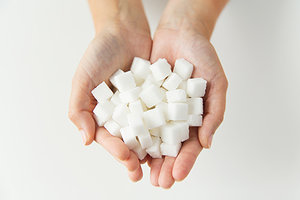East Asian medicine clearly is very old, so it is often difficult to change the way we think about certain diagnostic processes. If we want an example of how much trouble it is to change collective thinking, we can simply look to Dr. Mirkin's "Rest, Ice, Compression, Elevation" acronym (RICE) he created in the 1970s. In 2015, he tried to re-educate everyone, stating that ice actually kills tissue and delays healing;1 yet, here we are in 2022 with practitioners still espousing the benefits of using ice on a regular basis for all sorts of conditions.
An Intriguing Observation
 We're all taught that certain foods cause dampness: bananas, bread, dairy products, fatty meats, certain nuts like roasted peanuts, processed foods, and, of course, sugar. However, what I kept learning through my patients was that excess sugar consumption (when not contained within what I consider real food: meats, nuts, vegetables and fruits) was causing dryness.
We're all taught that certain foods cause dampness: bananas, bread, dairy products, fatty meats, certain nuts like roasted peanuts, processed foods, and, of course, sugar. However, what I kept learning through my patients was that excess sugar consumption (when not contained within what I consider real food: meats, nuts, vegetables and fruits) was causing dryness.
Patients who experience a lot of hot flashes and night sweating are typically yin deficient, and I have heard from all of them that they can exacerbate their symptoms by drinking red wine or hot spirits. This makes sense. Hot makes heat, of any kind, worse. Then I had a patient who told me their symptoms would get worse if they ate a lot of sugar. This piqued my interest because this didn't really line up with my educational thinking, so I started paying attention and asking the right questions.
I started asking any patient who was suffering from either minor or severe yin deficiency signs to monitor how they felt when consuming excess sugar. Time and time again, they said their dryness symptoms got worse. I started experimenting with my own body by consuming a lot of sugar. I found I would become very thirsty, my throat would become dry, and the coating would come off the back of my tongue.
When sugar enters the bloodstream, water leaves cells in order to balance the blood. Within five to 10 minutes of eating a dessert, one can feel thirsty – which is often chased by a sugary drink. If blood sugar levels remain elevated for prolonged periods of time, the kidneys get involved and use urine as a means to excrete excess sugar. In short, we dry out.2
The Worst of Both Worlds
Sugar is hygroscopic, meaning it attracts and bonds with water. We see this in baking; it makes things sticky. What happens to patients after they initially dry up is that they start to experience damp and phlegm signs, and this becomes the worst of both worlds: dryness and dampness together. Add in that most foods that contain a lot of sugar are dry in nature as they are baked. This requires more water and causes stomach-yin deficiency.3
Through my experience, I now believe there are three types of dampness: 1) External pathogenic Factor; 2) The kind we eat directly; and 3) The kind that forms when things start drying up.
In clinic, it's important to keep our ears and minds open to experience new information our patients may give us – that shakes our educational foundations a bit. In this case, I have found that in treatment it is just as important to address the dryness while treating dampness and phlegm.
References
- Mirkin G. "Why Ice Delays Recovery." DrMirkin.com, Sept. 16, 2015.
- Levi A. "Here's Why Sugar Makes You So Thirsty." Health.com, last updated June 15, 2020.
- Maciocia G. Chinese Medicine: Stomach-Yin Deficiency." Giovanni-Maciocia.com.
Click here for more information about Kenton Sefcik, RAc, Dipl. Ac., Dipl. TCM.




